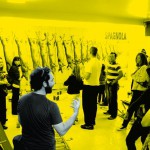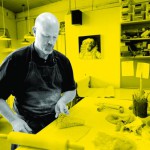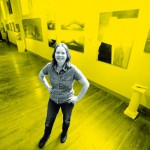- “once in a while I’ll sell a little something,” says Paul Hersey, whose business, Organic Armor, thrives online and depends little on foot traffic. “But you never know who might come through here. It might be a major connection.” Jonathan Welch
- Destination arts: LaZoom’s new art tour takes people through the RAD. Local artist Gabriel Shaffer dreamed up the concept, and leads the groups. Zen Sutherland
- “Five years ago the only sign we had to help people find the RAD from downtown was a billboard,” says artist Michael Hofman. “I used to have people come in and literally yell at me because they had such a hard time finding us.” Jonathan Welch
- “We view our artwork as more than a product to be bought and sold,” says artist Brit Øie, who works out of Riverside Studios. “It is inspiring to see people responding to our work and having a meaningful experience. Jonathan Welch
This weekend, thousands of art enthusiasts — tourists and locals alike — will descend on the River Arts District for the biannual Studio Stroll. There’s been a gale of change since last November’s stroll: at least four new restaurants, a theater and several new studio and gallery spaces have opened, and new sidewalks and a roundabout have been constructed (That’s a feat in this part of the world).
The transformations create new dynamics for the artists of the RAD, all of whom play an integral part in the area’s development. Xpress checked in with some of them on the eve of the stroll. What are the benefits and challenges that come with the increased number of visitors knocking on studio doors, and how did it even come to this in the first place?
Evolving quite literally overnight
It’s easy to understand why so many artists and businesses are establishing themselves in the RAD. A community of artists provides an endless source for collaboration, networking and support. The rich industrial landscape is a creative muse for many with its renovated warehouses, silos, graffiti-ed walls and bursts of greenery. Buildings are bought, sold, repainted, repaired and demolished, and the RAD’s appearance constantly evolves, oftentimes changing — quite literally — overnight.
Fiber artist Pattiy Torno witnessed and aided the RAD’s evolution. In 1989, she bought three buildings on the corner of Lyman Street and Riverside Drive, in part to open a punk-rock club. “When I got the buildings there was only one toilet, no heat, the roof didn’t work and everything was three-phase electric [set up for industrial use only],” she says. Torno’s club, The Squashpile, was open for a couple of years (though it’s legendary for those who were around at the time). Then she decided to convert her buildings into five separate live/work studios for artists.
In September 2004, massive rainfall from Hurricane Frances and Ivan caused the French Broad River to swell and flood the buildings along the river, including Torno’s. “I could not allow people to live on the ground level anymore,” she says. “I also figured that more people would be able to make a living selling their art out of my buildings if they became known as a retail destination, rather than a live/work space.” She gave the buildings a name: “Curve Studios,” which dovetailed into larger efforts to brand the district.
“That was when Clingman Café and 12 Bones opened, and all of a sudden we had a place to eat lunch. That really gave us a community,” says Torno. “Later on, the Wedge Brewery opened for evening hours, and suddenly the district felt cozy and safe at night. Last week The Junction and White Duck Taco opened. Now we can say, ‘You can come have dinner in the River Arts District.’ You didn’t used to be able to say that.”
How do we get there?
In zoning terms, the city of Asheville classifies the banks of the French Broad and Swannanoa rivers as the "river district.” As a member of the city’s River District Design Review Committee, Torno realized back in 2005 that the artists needed to distinguish their location within that 14-mile corridor. She began campaigning for the mile-long section of the riverfront that housed the burgeoning artist enclave to be known as Asheville's "River Arts District."
After a five-year branding process, "River District Artists" officially became "River Arts District Artists.” Around the same time, the Chamber of Commerce and the city of Asheville included the area in its wayfinding program — a system of directional signage for points of interest.
It’s a good thing, too. As many have learned the hard way, driving to the RAD isn’t necessarily intuitive. The most accessible route from downtown requires a detour through a half-loop from Patton Avenue onto Clingman Avenue (which later becomes Haywood Road). The studios themselves are spread out, and plotting a course to see them all can turn into a complicated task.
Michael Hofman, a potter whose ceramic studio is prominently located on the corner of Clingman Avenue and Roberts Street, attests: “Five years ago the only sign we had to help people find the RAD from downtown was a billboard. I used to have people come in and literally yell at me because they had such a hard time finding us.”
Signs helped. So did wider distribution of RAD promotional materials, and more trolley tours depositing tourists in the RAD. Artists saw foot traffic increase tenfold, and in turn businesses like Hofman’s thrived. “65 percent of my sales are from walk-ins,” he says. “My sales double every year.”
Torno has also seen a huge increase in the sale of her fleece clothing. “From 2008-2009, my retail sales went up 300 percent,” she says. Now, one of her biggest concerns is meeting demand for her products.
Doing the time to make the sales
“Since the recession, people don’t have money to spend on big-ticket items, but they still have a discretionary income to make small purchases,” says Hofman, who sells his hand-built porcelain wares in the price range of $25 to $600. In spite of the recession, Hofman’s sales are so good that, like Torno, he has a hard time keeping his shelves stocked.
Brit Øie is a painter and manager of the newly renovated Riverside Studios on Riverside Drive, which she shares with five other artists. Øie thinks the tourists want to buy smaller (and less expensive) items. “The tourists, I think, come here (to Riverside Studios) to look and enjoy. I don’t think they have any intention to buy. I always get the same response — that people are afraid to take paintings on the plane,” says Øie. “So I have only sold a few pieces and those have been to people living in this (WNC) area.”
Øie creates mixed-media landscapes and abstracts using embossed papers and paint. She’s debated making smaller paintings, but hasn’t wanted to produce prints that could sell at a lower price point. “I think the whole tactile quality of my work would be compromised. For me, the quality of the artwork is more important than mass-producing to sell as much as possible,” she says.
Nevertheless, Øie stresses that the artists of Riverside Studio appreciate the foot traffic they get. “We view our artwork as more than a product to be bought and sold,” she says. “It is inspiring to see people responding to our work and having a meaningful experience.”
The conundrum of keeping regular hours in the studio each week is a challenge faced by many artists in the district who have other obligations — employment, or children, for example. Øie works part time as a housecleaner, but tries to be in her studio at least 30 hours each week.
“I think it’s important to acknowledge that if you want to be an artist, you have to do other things while you are building a career,” she says. Since her studio mates are also busy with other obligations, they divide their time to ensure that Riverside Studios is open every day.
As someone who maintains a consistent presence in his studio, Hofman points out that often tourists are disappointed when they make a trip to the RAD, only to find many studios closed. He understands the predicament. “What makes the RAD unique is that these are working studios,” Hofman says. “In other places, when you visit an arts district, really you are visiting a place where there are a lot of galleries. I think when people get that concept it makes the visit all the more special.”
Chatting up visitors: boon or burden?
For many artists in the RAD, sales to roving tourists are not necessarily what they rely on to maintain their business. Paul Hersey and Jennifer Murphy own the costume business Organic Armor, in the Riverview Station on Lyman Street. The couple produces latex costumes like cloaks, breastplates, masks, headpieces and armbands. The majority of their sales are made to a niche clientele via the Internet.
Foot traffic, says Murphy, increases with the warm weather, and generally visitors will come across the studio by chance due to its out-of-the-way location (and proximity to a dog school). “Once in a while I’ll sell a little something,” says Hersey. “But you never know who might come through here. It might be a major connection or something.”
Like many other artists in the RAD, Hersey admits that while he enjoys people’s interest in his fantastical designs, chatting up visitors can be distracting when he has a large order to fill.
“Sometimes people just come right into my studio — even though my door is closed — and they sort of have an expectation like this is a department store or something, and they don’t really understand that this is a working studio,” he says.
Torno has encountered similar issues, but says there is some work she can easily do while interacting with clients, like working at her sewing machine or on the computer. She pieces her quilts together in the privacy of her home, which allows for the intense focus required to make them. “One of the benefits of having a studio in the RAD is that you get your chops down,” says Torno. “You learn how to read who’s serious and who’s not. You get good at talking about your work, which is great career development.”
It’s not just about trying to sell something
In the mid-‘90s, when only a handful of artists had studios in the district, the now-crowded and chaotic studio strolls were conceived as a way to draw people to the area.
With the growth of the River Arts District Artists organization, the strolls got much more publicity — and grew tremendously. Members of RADA pay dues that go toward the production of a handy brochure and map. As RADA continues to grow, so does its annual budget, ensuring greater publicity each year.
Still, many artists see the stroll mostly as an opportunity to network, rather than make actual sales. “It’s not a day for getting work done, but we do want to let people know we’re here, and that we’re associated with the art scene,” Hersey says. “It’s not just about trying to sell something.”
The stroll offers everyone the opportunity to celebrate the River Arts District in all its various incarnations — from the carnival-esque vibe of the Phil Mechanic Building, to the more refined ambience of Cottonwood Studios. The revitalized and colorful Pink Dog Creative studio brings a more contemporary element to the fold, among stalwarts like Odyssey Clay and Wedge Studios.
“I have kids come to the stroll from my school — they look forward to it,” says Ginger Huebner, an art teacher who just relocated her painting studio to the Pink Dog Creative Studio on Depot Street. “The stroll is a weekend when everyone is welcomed. That’s what I’d like to see more of. We have the opportunity to make the RAD a place that’s engaging to everyone, not just tourists. I want to see it become a place where people in Asheville feel like they can come and explore the arts in a special way because they live here. We are all in this together.”
The question in the back of everyone’s mind remains: What is the future of the RAD? In many cities, the influx of artists occupying cheap studio spaces generally heralds the threat of gentrification, i.e., burgeoning arty enclaves raise the public’s interest in a place, property values increase, rents increase and the artists and residents of a neighborhood are forced to move out.
When asked about this possibility, Torno points out that most of the buildings in the RAD are owned by artists, like Randy Schull (owner of Pink Dog Creative), and painter Wendy Whitson who just bought a building on Depot Street. “That’s where the RAD has an ace in our back pocket, ” says Torno. “Our hearts are vested in this neighborhood. If you’re heart is not vested in a neighborhood, all you’re in it for is the money.”
— Ursula Gullow writes about art for Mountain Xpress and her blog, artseenasheville.blogspot.com.
what: River Arts District Studio Stroll
where: Nineteen historic buildings in the River Arts District. Map at riverartsdistrict.com. Information booth located at 5-points intersection of Depot Street across from Clingman Cafe.
when: Saturday, June 11 and Sunday, June 12 (10 a.m. to 6 p.m.)








This is an interesting and well-written piece that brings up and examines very interesting points about the whole artist-and-asheville world. Much like the powerful ramblings of Gabriel Shaffer in his LaZoom art tour. Getting us to think about, and like, artists is a gift that Mx gives so well.